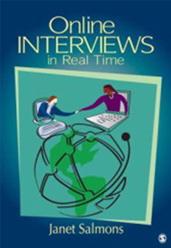Online Interviews in Real Time

Salmons, J. (2010)
Reviewer: Michael G Dilcock
This book is of significant use to both researchers and students who are actively involved in the preparation of various types of interviews whether inclusive or exclusive to online interviewing. The inherent benefit arises as each chapter presents deliberations and assignments, providing enhanced appreciation of the practice, process and procedure attributable to online interviewing. Within the context of this book online interviewing is predominantly aligned to:
- Video conferencing
- 3D immersive environments
- Social networking
- Text messaging
- Multi-channel meetings
Supplementary information directly associated to the book and its subject matter can be found on the book’s website: www.sagepub.com/salmonsstudy. This website is updated on a regular basis due to continuing changes in communicative technology post book publication.
The compositions of varying forms of interview(s) are considered, for example:
- Structured
- Semi-structured
- Unstructured
- Co-constructed
- Creative
- In-depth
- Oral
- Active
- Historical
From this wide appreciation of considerations clear and informative arguments are levelled both for and against ‘online interviews in real time’ (ORIT) as opposed to the accepted norms of personal interviews. This is an important correlation for the reader as at the time of writing ‘personal interview’ techniques remain firmly pre-eminent in society as opposed to this relatively newly emerging ICT phenomenon. However, in furtherance of support of ORIT differing types of online communicative processes are presented providing information of those technologies deemed most suitable for research purposes, i.e. text and multi-channel. Each of the books topics are illustrated by way of various tables and figures.
The theory and practice akin to research (research methods) are multifarious and very often inexorably linked, particularly where ‘triangulation’ facilitates the validation of data through cross verification from more than two sources. The book does therefore present ‘some’ of the basic interrelationships between research design, theory, epistemologies (disambiguation), methods and methodologies akin to research design. However, it is fair to state that which is presented is a ‘broad brush’ appreciation and the reader would be well advised to read further and deeper in order to gain the organising insights needed for any one specific research intention. In practical terms the book does to its credit provide necessary cognisance to the mutual consent of participants, which turns on the highly topical and ongoing debates vis-à-vis how private is actually private in the internet continuum?
Each of the books chapters correspond to the sequential steps of the online interviewing process:
- Determine question
- E-research strategy
- Technology choice
- Ethical evaluation
- Sampling plan
- Participant recruitment
- Interview preparation
- Conducting interviews
- Data verification
- Analysis
- Findings report
A variety of procedures for selection and sampling of participants for interview are considered, i.e. purposeful and probability sampling. Sampling is classified in a table format indicating the particular form inclusive of the advantages for use. Suggestions for ensuring the credibility of research participants are made for example, the ‘nomination approach’ is reliant upon identity verification by another individual who knows the potential participant, in short, trustworthy third party verification. An ‘existing approach’ is dependent upon substantiation by way of organisational affiliation.
The numerous stages in conducting online interviews are considered in tandem with several illustrations of real interviews, one of which was conducted by the book’s author. The book presents numerous technological aids that support both researcher and participant in the process of cross-communication, i.e. visual modes, and considers future trends in research via online interviewing. A reasonable literature review of qualitative data analysis is contained in the appendix and a glossary of terms concludes the book.


